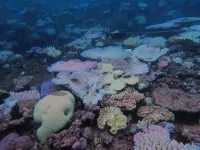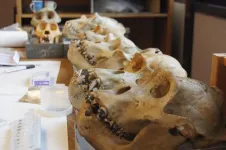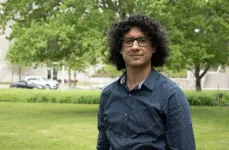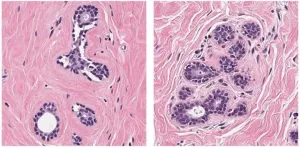(Press-News.org) Clavelina oblonga, an invasive marine fouling species, not only reduces diversity in communities it invades, it also interferes in their recovery following natural disasters - a process known as "succession."
Succession refers to how an ecosystem recovers after a disturbance or natural disaster - does the system come back more or less the same as it was in terms of species composition, or is it different?
"The classic example of succession is a forest that experiences a wildfire," says Kayla Christianson, former NC State graduate student and first author of a paper describing the research. "As the community recovers from the fire, it proceeds through a predictable pattern of community development - starting with grasses and ending with trees and a mature forest. This predictable order of succession is due mainly to the seed bank beneath the soil, which allows the community to recover regardless of when the disturbance occurs."
However, marine fouling communities don't follow the same pattern as terrestrial ecosystems. Marine fouling species are invertebrate filter-feeding organisms - like barnacles or mussels - that settle on hard substrates, like docks, pilings, or ship hulls. Soft-bodied tunicates such as the invasive C. oblonga are also fouling species.
"Marine fouling environments are different because different species of larvae are present at different times of the year, so what the ecosystem looks like after a disturbance depends on when it occurs," says David Eggleston, professor of marine, earth and atmospheric sciences at North Carolina State University and corresponding author of the research. "For marine species, disturbances enhance community diversity."
Given the recent introduction and proliferation of C. oblonga along the North Carolina coast, Eggleston and Christianson wanted to see how this invasive species would affect succession in a fouling environment.
Christianson and Eggleston duplicated succession experiments performed 50 years ago in Beaufort, N.C. They submerged terra cotta settlement plates every four weeks from May 2017 to September 2018 along the docks and observed the communities that settled there.
Over the course of the study, 22 different fouling species settled on the plates. But in each case, when C. oblonga settled, they rapidly crowded out the other species. The study period also included an unseasonably cold winter, as well as landfall from Hurricane Florence in September 2018, enabling the researchers to look at succession after a natural disturbance. While both the cold and the hurricane succeeded in removing C. oblonga, it quickly regrew and crowded out other species, eliminating species diversity.
"In retesting succession theory we found that it holds in the absence of invasive species but not in their presence," Eggleston says. "For these fouling species, regardless of when a disturbance occurs, the community always reverts back to the invasive species.
"C. oblonga has only been here since 2015, but it seems to have no real natural predators, it crowds out native species and it has a foothold. We will have to monitor this species and be sure that it doesn't impact our local shellfish industry."
INFORMATION:
The research appears in Ecosphere and was supported by North Carolina Sea Grant (grant R12-HCE-2) and the National Science Foundation (grant OCE-1155609).
Note to editors: An abstract follows.
"Testing Ecological Theories in the Anthropocene: Alteration of Succession by an Invasive Marine Species"
DOI: 10.1002/ecs2.3471
Authors: Kayla Christianson, David Eggleston, North Carolina State University
Published: April 23, 2021 in Ecosphere
Abstract:
Ecologists employ a diverse body of theory to help explain patterns and processes in ecological systems, with the consistency of ecological theories tested against an increasingly altered world. The global redistribution of species is a prominent impact of climate change and human-mediated biological invasions, and often results in negative impacts to ecosystems. Recently, a species of colonial tunicate not previously present, Clavelina oblonga, has become prominent within the marine fouling community of Beaufort, North Carolina, USA. Fifty years ago Sutherland and Karlson (1977), in testing theories of ecological succession developed in terrestrial systems, found that this marine community was characterized by a heterogeneous mixture of species that varied inter-annually (i.e., multiple community states) and increased in diversity over time. Recently, Theuerkauf et al. (2018) found that the fouling community is dominated by C. oblonga with patterns of community development and structure that led to the loss of alternative community states, domination by C. oblonga, and reduced species diversity. The present study addressed the question: will patterns of community development identified over 50 years ago still operate under reduced cover of invasive C. oblonga? This study also quantified the impacts of two large-scale, environmental disturbances (extremely cold winter & hurricane) on the abundance of C. oblonga and the resulting fouling community. C. oblonga remains a dominant component of the fouling community due to its rapid growth and strong seasonal recruitment. Under conditions of reduced percent cover of C. oblonga, the local fouling community displayed unique community states that became even more distinct over time, consistent with the pattern of multiple community states identified by Sutherland and Karlson (1977) that were dependent upon date of disturbance. Natural disturbances in this study caused by a harsh winter and a hurricane greatly reduced the presence of C. oblonga. This experiment advanced our understanding of marine community ecology by testing if the concept of multiple community states identified over 50 years ago by Sutherland and Karlson (1977) is still operable in the absence of invasive C. oblonga, and highlights how natural environment disturbances can potentially moderate the spread of this invasive tunicate.
Since it debuted in 2011, the Get SET Early program, which provides pediatricians and parents with a relatively simple process to screen for indicators of autism spectrum disorder (ASD) in children as young as age 1, has steadily grown in use and validation. Early screening and identification of ASD has been linked to more effective treatment.
A new study, published in the April 26, 2021 issue of the END ...
PHILADELPHIA-- Human brain organoids are remarkable platforms for modeling features of human brain development and diseases. Building on methods to generate organoids to model different brain regions such as the cortex and the midbrain, researchers at the Perelman School of Medicine at the University of Pennsylvania have generated the first organoids of the arcuate nucleus (ARC), an essential structure in the hypothalamus that sends signals of hunger and feeling full. This part of the hypothalamus exhibits a tremendous amount of cell diversity, and is far more complex than previously modeled parts of the brain.
In a paper ...
Scientists have made major advances in understanding and developing treatments for many cancers by identifying genetic mutations that drive the disease. Now a team led by researchers at Weill Cornell Medicine, NewYork-Presbyterian and the New York Genome Center (NYGC) has developed a machine learning technique for detecting other modifications to DNA that have a similar effect.
The study, published May 10 in Cancer Discovery, a journal of the American Association for Cancer Research, focuses on a type of chemical modification to DNA, called methylation, that typically silences nearby genes. The new technique can analyze the thousands of DNA methylation changes detected in tumor cells and infer which ones are likely ...
HOUSTON - Researchers at The University of Texas MD Anderson Cancer Center have developed a first-of-its-kind spatial atlas of early-stage lung cancer and surrounding normal lung tissue at single-cell resolution, providing a valuable resource for studying tumor development and identifying new therapeutic targets. The study was published today in Cancer Discovery, a journal of the American Association for Cancer Research.
The findings reveal a heterogeneous lung cancer ecosystem, with extensive interactions between cancer cells and the surrounding microenvironment that regulate early cancer development. ...
New research on the growth rates of coral reefs shows there is still a window of opportunity to save the world's coral reefs--but time is running out.
The international study was initiated at the ARC Centre of Excellence for Coral Reef Studies (Coral CoE), which is headquartered at James Cook University (JCU).
Co-author Professor Morgan Pratchett from Coral CoE at JCU said the results show that unless carbon dioxide emissions are drastically reduced the growth of coral reefs will be stunted.
"The threat posed by climate change to coral reefs is already very apparent based on recurrent episodes of mass coral bleaching," Prof Pratchett said. "But changing environmental conditions will have other far-reaching consequences."
Co-author Professor Ryan Lowe, from Coral CoE at The University ...
A new study looking at the evolutionary history of the human oral microbiome shows that Neanderthals and ancient humans adapted to eating starch-rich foods as far back as 100,000 years ago, which is much earlier than previously thought.
The findings suggest such foods became important in the human diet well before the introduction of farming and even before the evolution of modern humans. And while these early humans probably didn't realize it, the benefits of bringing the foods into their diet likely helped pave the way for the expansion of the human brain because of the glucose in starch, which is the brain's main fuel source.
"We think we're seeing evidence of a really ...
ORLANDO, May 10, 2021 -University of Central Florida researchers are building on their technology that could pave the way for hypersonic flight, such as travel from New York to Los Angeles in under 30 minutes.
In their latest research published in the journal Proceedings of the National Academy of Sciences, the researchers discovered a way to stabilize the detonation needed for hypersonic propulsion by creating a special hypersonic reaction chamber for jet engines.
"There is an intensifying international effort to develop robust propulsion systems for hypersonic and supersonic flight that would allow flight through our atmosphere at very high speeds and also allow efficient entry and exit from planetary atmospheres," ...
In a newly published paper, Virginia Tech geoscientists have found that shallow wastewater injection -- not deep wastewater injections -- can drive widespread deep earthquake activity in unconventional oil and gas production fields.
Brine is a toxic wastewater byproduct of oil and gas production. Well drillers dispose of large quantities of brine by injecting it into subsurface formations, where its injection can cause earthquakes, according to Guang Zhai, a postdoctoral research scientist in the Department of Geosciences, part of the Virginia Tech College of Science, and a ...
Breast cancer has recently overtaken lung cancer to become the most common cancer globally, END ...
Endometriosis, a disease found in up to 10 per cent of women, has been enigmatic since it was first described. A new theory developed by researchers at Simon Fraser University suggests a previously overlooked hormone -- testosterone -- has a critical role in its development. The research could have direct impacts on diagnosis and treatment of the disease, signaling hope for women with endometriosis worldwide.
The disease is caused by endometrial tissue growing outside of the uterus, usually in the pelvic area, where it contributes to pain, inflammation, and infertility. But why some women get it, and others do not, has remained unclear.
The new research is based on recent findings that women with endometriosis developed, as fetuses in their mother's womb, under conditions of relatively ...





